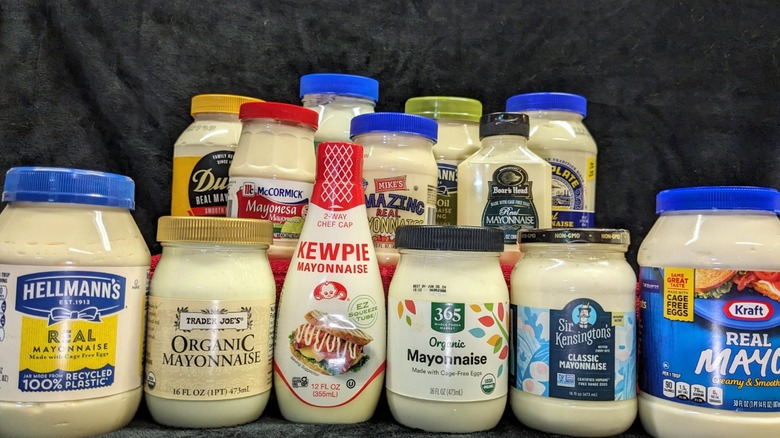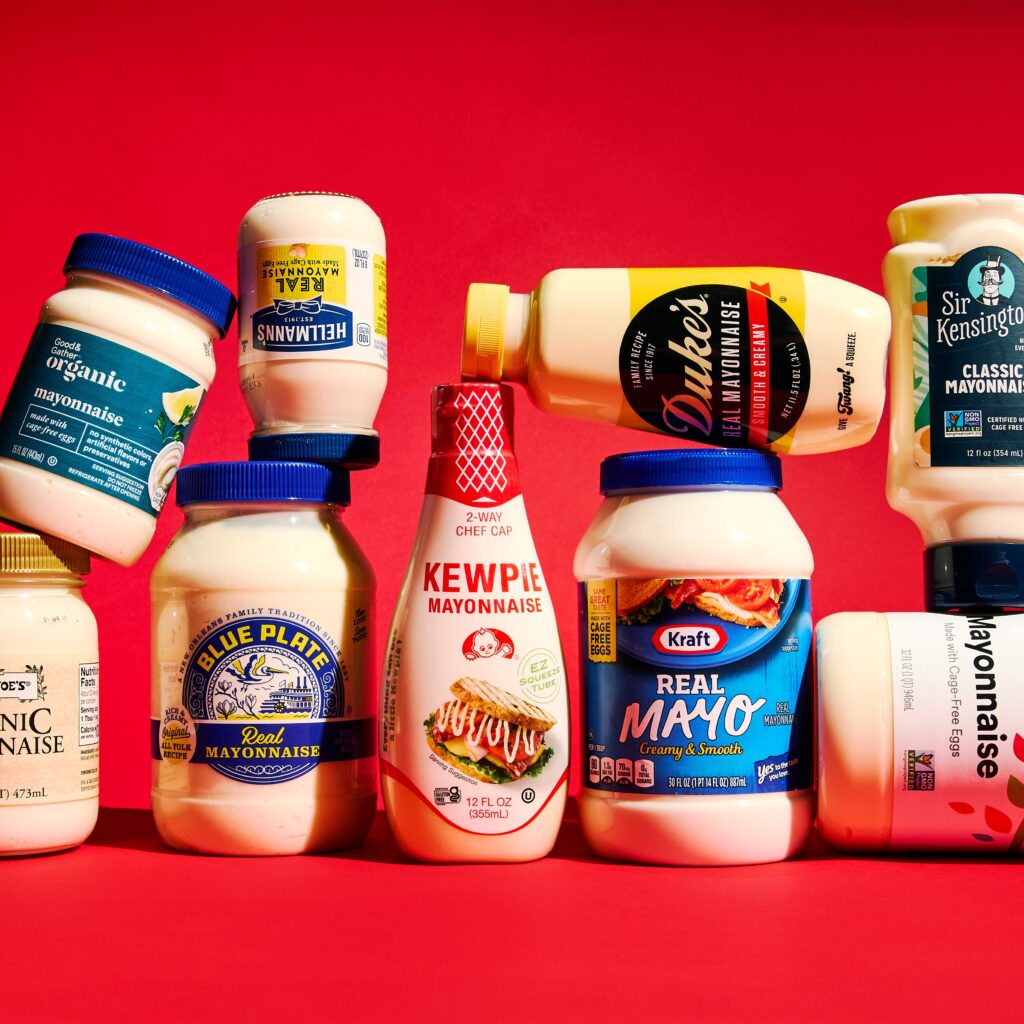Mayo Branding is a fascinating subject. It mixes marketing with culinary arts.
Mayo, short for mayonnaise, is a staple in many kitchens. But did you know it can also be a powerful branding tool? Companies use mayo to create unique identities and connect with customers. Think about your favorite sandwich or salad.
The mayo brand can make a difference. In this blog, we’ll explore how mayo is more than just a condiment. It’s a symbol, a story, and a strategy. From packaging design to marketing campaigns, mayo branding is an art. Ready to learn how this creamy condiment can shape a brand? Let’s dive into the world of mayo branding.
:max_bytes(150000):strip_icc()/__opt__aboutcom__coeus__resources__content_migration__serious_eats__seriouseats.com__images__2013__07__20130717-mayonnaise-taste-test-03-509318e6c89e4f838b03ee28a7e14278.jpg)
Credit: www.seriouseats.com
Introduction To Mayo Branding
Understanding the essence of branding is crucial for any business. Mayo Branding provides a unique approach to help businesses establish a strong presence. This section will explore what Mayo Branding is and why it is important for businesses.
What Is Mayo Branding?
Mayo Branding is a comprehensive strategy aimed at creating a distinct and memorable brand identity. It involves a blend of visual elements, messaging, and customer experiences. The goal is to convey a consistent and appealing brand image.
The process includes:
- Defining core brand values
- Crafting a unique brand voice
- Designing logos and visual assets
- Developing brand guidelines
These elements work together to create a cohesive and recognizable brand.
Importance For Businesses
The importance of Mayo Branding for businesses cannot be overstated. A strong brand identity helps businesses:
- Build Trust: Consistent branding makes a business appear professional and reliable.
- Stand Out: Unique branding helps a business distinguish itself from competitors.
- Attract Customers: A strong brand attracts customers and fosters loyalty.
- Increase Value: Strong brands can command higher prices and increase business value.
Investing in Mayo Branding can lead to long-term benefits and business growth.

Credit: www.tastingtable.com
Crafting A Unique Brand Identity
Creating a unique brand identity is essential. It sets your business apart. A strong brand identity builds trust. It ensures customers recognize and remember you.
Defining Your Brand
Start with defining your brand. This involves understanding your core values. What makes your business unique? Think about your mission and vision. Who is your target audience? Answer these questions clearly. They form the foundation of your brand identity.
Next, create a brand voice. How do you want to communicate with your audience? This could be friendly, professional, or quirky. Ensure your brand voice aligns with your values and resonates with your audience.
Creating A Memorable Logo
A logo is a visual representation of your brand. It is often the first thing people notice. A memorable logo should be simple, yet unique. It should reflect your brand’s personality.
Consider the following elements when designing your logo:
| Element | Description |
|---|---|
| Color | Choose colors that evoke the right emotions. Colors should align with your brand’s message. |
| Typography | Select fonts that are readable and match your brand’s tone. |
| Iconography | Incorporate symbols that are relevant to your brand. Icons should be simple and recognizable. |
Test different logo designs. Get feedback from your audience. Choose the one that best represents your brand.
Remember, your logo is part of your brand identity. It should be consistent across all platforms. This includes your website, social media, and marketing materials.
Building Brand Awareness
Building brand awareness is crucial for the success of any business. It helps potential customers recognize and remember your brand. For Mayo Branding, creating a strong brand presence can lead to increased customer loyalty and sales. Let’s explore some effective strategies to boost brand awareness.
Effective Marketing Techniques
There are several marketing techniques that can help build brand awareness. Here are a few:
- Content Marketing: Create valuable content that informs and engages your audience. Blog posts, videos, and infographics are great options.
- Email Marketing: Send regular newsletters and updates to keep your audience informed about your brand and offerings.
- Event Marketing: Host or participate in events to connect with your audience in person.
- Influencer Marketing: Partner with influencers to reach a wider audience and build credibility.
Utilizing Social Media
Social media platforms are powerful tools for increasing brand awareness. Here are some tips for utilizing social media effectively:
- Choose the Right Platforms: Identify where your target audience spends their time online. Focus your efforts on those platforms.
- Engage with Your Audience: Respond to comments, messages, and mentions. Show that you value their input and feedback.
- Post Consistently: Regularly update your social media profiles with fresh content. Consistency helps keep your brand top of mind.
- Use Visuals: Share images, videos, and graphics to capture attention and convey your message effectively.
- Leverage Hashtags: Use relevant hashtags to increase the visibility of your posts and connect with a broader audience.
Engaging Your Audience
Engaging your audience is key to successful Mayo Branding. By creating a connection, you can build trust and loyalty. This section will explore how to develop a brand voice and customer interaction strategies.
Developing A Brand Voice
Creating a unique brand voice helps your audience recognize and relate to your brand. Follow these steps to develop a strong brand voice:
- Define your brand’s personality: Is it formal or casual? Friendly or professional?
- Be consistent: Use the same tone and style across all platforms.
- Know your audience: Understand their language, interests, and needs.
- Be authentic: Stay true to your brand values and mission.
Customer Interaction Strategies
Effective customer interaction strategies can help you engage your audience better. Here are some tips:
| Strategy | Description |
|---|---|
| Personalized Messages | Send tailored messages to make your customers feel valued. |
| Social Media Engagement | Respond to comments and messages promptly. |
| Content Sharing | Share relevant and interesting content regularly. |
| Feedback Collection | Ask for and act on customer feedback. |
Engage your audience by listening and responding to their needs. This builds a strong relationship and fosters loyalty.
Consistency Across Platforms
Consistency is key to effective branding. It ensures that your audience recognizes and trusts your brand. Mayo Branding excels in maintaining this consistency across all platforms.
Unified Brand Messaging
Unified brand messaging helps create a strong, cohesive identity. Mayo Branding ensures that all communications align with your brand values and voice.
- Define your brand’s core message.
- Use the same tone of voice across all platforms.
- Ensure all team members understand the brand guidelines.
By following these steps, your brand message remains clear and recognizable.
Visual And Content Consistency
Visual and content consistency strengthens brand recognition. Mayo Branding ensures your visuals and content are consistent across all channels.
| Element | Consistency Tips |
|---|---|
| Logo | Use the same logo in all materials. |
| Color Scheme | Stick to a defined color palette. |
| Typography | Use consistent fonts and styles. |
| Imagery | Maintain a consistent style and quality. |
In addition, ensure your content follows the same guidelines. This includes blog posts, social media updates, and any other written materials.
- Stick to a consistent posting schedule.
- Use similar formats for similar types of content.
- Maintain a uniform tone and style.
By maintaining visual and content consistency, your audience will easily recognize and trust your brand.
:max_bytes(150000):strip_icc()/__opt__aboutcom__coeus__resources__content_migration__serious_eats__seriouseats.com__images__2013__08__20130717-mayonnaise-taste-test-primary-new-7fe90982ff024ab49e3ba782b8d2d03c.jpg)
Credit: www.seriouseats.com
Leveraging Brand Partnerships
Leveraging brand partnerships can significantly enhance a company’s reach and influence. By collaborating with other brands, businesses can tap into new markets and create more compelling marketing campaigns. This approach is particularly effective in the competitive landscape of the food industry, where standing out is crucial.
Identifying Potential Partners
To identify potential partners, start by analyzing brands that align with your values. Look for companies that share a similar target audience. This ensures that the collaboration is mutually beneficial.
Market research plays a key role. Use tools like surveys and social media analytics. These tools help identify brands that resonate with your audience.
Create a list of potential partners. Evaluate their market presence and customer engagement. This information helps in making an informed decision.
Benefits Of Collaboration
Collaboration offers several benefits. First, it increases brand visibility. Partnering with a well-known brand can introduce your products to a larger audience.
Second, it enhances credibility. When you partner with a trusted brand, your business gains trust by association. This can lead to increased customer loyalty.
Third, it allows for resource sharing. This can include marketing budgets, distribution channels, and even product development insights.
| Benefit | Description |
|---|---|
| Increased Visibility | Reach a broader audience through shared platforms |
| Enhanced Credibility | Gain trust by associating with a reputable brand |
| Resource Sharing | Share marketing, distribution, and development resources |
In summary, leveraging brand partnerships can provide significant advantages. It can help you reach new customers and build a stronger brand presence.
Measuring Brand Success
Understanding the impact of your branding efforts is crucial. This involves evaluating various metrics to determine how well your brand is performing. Effective measurement can guide your strategies and help you achieve your goals.
Key Performance Indicators
Key Performance Indicators (KPIs) are essential in measuring brand success. Here are some important KPIs to consider:
- Brand Awareness: Track how well your brand is recognized by your target audience.
- Customer Engagement: Measure the level of interaction your audience has with your brand.
- Sales Performance: Assess how branding efforts contribute to sales growth.
- Market Share: Determine the percentage of your industry controlled by your brand.
- Customer Retention: Monitor the rate at which customers return to your brand.
Adjusting Strategies Based On Data
Data-driven decisions are vital for improving branding strategies. Analyze collected data to identify strengths and weaknesses. This process helps in refining your approach for better outcomes.
Here are some steps to adjust strategies based on data:
- Collect data through various sources like surveys and analytics tools.
- Analyze trends and patterns to understand performance metrics.
- Identify areas that need improvement.
- Develop new strategies addressing the identified gaps.
- Implement changes and monitor their effectiveness.
Regularly reviewing and adjusting your strategies ensures your brand stays relevant and competitive.
Future Trends In Branding
The world of branding is constantly evolving. Companies need to adapt and innovate to stay relevant. Let’s explore some future trends in branding that can help businesses stand out.
Adapting To Market Changes
Brands must adapt to changing market conditions. This means understanding customer needs and responding quickly. For instance, companies may adjust their messaging to reflect current events. This keeps the brand relevant and connected to its audience.
Another way to adapt is by embracing digital transformation. Many businesses are moving online. A strong online presence is crucial. Invest in a user-friendly website and active social media profiles.
Consider the following strategies:
- Monitor market trends and adjust strategies accordingly.
- Engage with customers through social media and other digital platforms.
- Utilize data analytics to understand customer behavior and preferences.
Innovative Branding Techniques
Innovation in branding can set a company apart. One way is through storytelling. Share your brand’s journey, values, and mission. This creates an emotional connection with customers.
Another technique is experiential marketing. Create memorable experiences for your customers. This can be through events, pop-up shops, or interactive online content.
Consider these innovative techniques:
- Use augmented reality (AR) to create interactive experiences.
- Incorporate sustainability into your brand. Customers value eco-friendly practices.
- Leverage influencer partnerships to reach a wider audience.
Table of innovative techniques and their benefits:
| Technique | Benefit |
|---|---|
| Storytelling | Builds emotional connection |
| Experiential Marketing | Creates memorable experiences |
| AR | Engages customers interactively |
| Sustainability | Appeals to eco-conscious customers |
| Influencer Partnerships | Expands reach |
Case Studies Of Successful Brands
Understanding the strategies behind successful brands can offer valuable insights. These case studies show how effective branding can transform a business. Let’s dive into some real-world examples and lessons learned from their journeys.
Real-world Examples
Here are some noteworthy brands that have excelled in their branding efforts:
| Brand | Strategy | Outcome |
|---|---|---|
| Apple | Focus on innovation and sleek design | Became a global tech leader |
| Nike | Inspiring advertisements and endorsements | Dominates the sportswear market |
| Coca-Cola | Consistent brand messaging and nostalgia | Recognized worldwide |
These brands have not only captured the market but also the hearts of their customers.
Lessons Learned
There are several lessons to learn from these successful brands:
- Consistency is key: Maintain a unified brand message.
- Know your audience: Understand and cater to their needs.
- Innovation matters: Stay ahead with new ideas and products.
Each brand’s approach offers something unique. For instance, Apple’s focus on sleek design and user experience sets it apart. Nike’s inspirational marketing connects deeply with their audience. Coca-Cola’s consistent messaging builds trust over time.
By studying these brands, businesses can learn valuable strategies. Implementing these lessons can help in building a strong, recognizable brand.
Frequently Asked Questions
What Is Mayo Branding?
Mayo Branding refers to the strategies used to promote mayonnaise products. It involves creating a unique identity and differentiating the product from competitors.
Why Is Mayo Branding Important?
Mayo Branding is crucial for standing out in a crowded market. It helps build customer loyalty and drives sales through effective marketing techniques.
How Do You Create A Strong Mayo Brand?
Creating a strong Mayo Brand involves understanding your target audience, developing a unique selling proposition, and consistently delivering quality.
What Are The Key Elements Of Mayo Branding?
Key elements include logo design, packaging, marketing campaigns, and brand messaging. These elements should align with the brand’s identity.
Conclusion
Mayo branding can elevate your business. It builds trust and recognition. Stay consistent in your message. Use clear and simple designs. Engage with your audience regularly. Monitor your brand’s performance. Make adjustments as needed. A strong brand identity pays off.
It attracts loyal customers. Start refining your brand strategy today. Watch your business grow.




